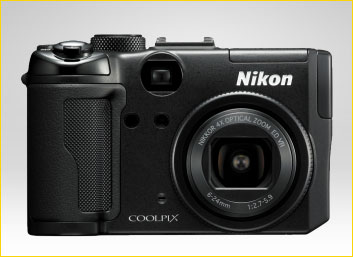

Pocket-sized digital cameras appeal to a wide constituency of photographers. Hockey moms love ’em (sorry Sarah), and pro photographers do as well, along with just about every other shade of picture taking folk in between.
The pro and the more serious amateur though are typically looking for one feature that more casual users don’t, (or even know about or care that it exists) and that’s the ability to shoot in raw mode. If you’re reading this you likely know that an in-camera JPG is a "baked" image. Things like white balance and sharpening are locked in and can take very little adjustment in post processing before deteriorating, often badly. A raw file has much more flexibility, and can be processed on the computer in much the same way that a negative could in the days of the darkroom. More creative freedom, in other words.
All DSLRs offer raw capability, but not many digicams. The number that offer it can be counted on not much more than the fingers of one hand, and the two (actually three) that are included here are the newest and in many ways the best of this small breed.

Frost Rimmed – Muskoka, Ontario. October, 2008
Canon G10 @ ISO 200
16mm (80mm equiv) 1/50sec f/3.5
The above is an example of what this new generation of pocket digicams is capable of. It was taken with the Canon G10,
but the Nikon P6000, as will be seen, is not that far behind in terms of resolution and overall image quality.
You can see a larger version by clicking on the picture, and below is a 100% crop of a center section.
Note – this was taken hand-held and at ISO 200.

____________________________________________________________________________________
And Then There Were Three
Though this is a comparative review of the new Nikon P6000 and Canon G10, there is another contender in the third corner – the Panasonic LX3, as well as its nearly identical though much more expensive cousin, the Leica D-Lux 4. I reviewed the LX3 on these pages just a couple of weeks before this report appears, and since it too falls in the category of pocket-sized high-spec digicams that can shoot raw, it should not be completely left out. It has a somewhat different feature set (no optical viewfinder, and a faster, wider and not as long zoom lens), but it’s in the same game, so from time to time I’m going to reference it here. Myearlier review of the Panasonic LX3should therefore be referenced first for this to make sense.
____________________________________________________________________________________
Features and Specs
Nikon and Canon are traditional rivals, like theHatfieldsand theMcCoys. They compete in just about ever segment of the market. But, in recent years Canon has, with its G series, had one small niche to itself, that of the pocketable digicam that shoots raw and has an optical viewfinder (pathetic though the latter may be).
Now, with the introduction by Nikon of the Coolpix P6000, and Canon’s upgrade to the G10, we have what appear at first blush to be competitive products in this category. Let’s see how they initially stack up.
Price
At the time that this is being written in late October, 2008, both cameras are selling atB&Hfor the same price – $499.95. The Panasonic LX3 is selling for somewhat less, at $463. (The Leica D-Lux 4 sells for a deluxe $850, therefore likely only being of interest to the Gucci crowd).
Size and Weight
The Nikon is a significantly smaller camera than the Canon. The P6000 weighs in at 280 grams while the Canon is 390 grams. The P6000 is shirt pocketable, while the G10 is coat pocketable. Neither is large by any means, but if you’re looking for something that will fit in your pants or shirt pocket, the P6000 is your choice, and is quite similar to the Panasonic LX3 in its portability. On the other hand you are always aware of the G10 by the bulge in your coat pocket.
The LX3 is the small size and low weight champ, coming in at 265 grams, and is the most pocketable of the three.
Chittenden Dawn. Vermont. October, 2008Nikon P6000 at ISO 64.
18mm. 1/3rd sec @ f/5
Sensor Resolution and Lens
At 14.7 megapixels the G10 has a higher resolution sensor than the P6000, which is 13.5 MP effective. This is an essentially trivial difference, and shouldn’t be a factor in anyone’s buying decision.
There are some who argue that these resolutions are too high. That manufacturers have gone a bridge too far in this regard, and that we’d all be better off with lower res but cleaner sensors. They may have a theoretical point there, but we’ll have to see if this applies in practice to these two new contenders.
In the lens department the Canon sports a 5X zoom lens, from 28mm – 140mm equivalent at f/2.8 – f/4.5. The Nikon’s lens is a 4X zoom, offering from 28mm to 112mm at f/2.7 to f/5.9.
These both offer similar coverage at the wide end, but the Nikon is somewhat shorter when it comes to telephoto, and also a half stop or so slower at that end. The LX3 on the other hand features a wider wide angle at 24mm, but only goes out to 60mm equivalent on the long end, possibly not long enough for some people’s needs. It is quite a bit faster than the other two at f/2 to f/2.8. Its 10.1 Megapixel sensor does bring it down a notch in the resolution department, but its ability to provide multiple aspect ratios without loss of resolution is a bonus in its favour.
Raw and OVF
Both cameras offer raw shooting capability, amustin my book for any camera that wishes to be taken seriously. Both also offer optical viewfinders as an alternative to using the rear LCD, something which I value in some situations.
To be frank though, I am beginning to consider this less important that I have in the past. The latest generation of rear LCD screens has gotten so good that I no longer am minding using them as much as I used to. I still find holding the camera away from my body a bit annoying, and its less stable than at eye level, but I suppose that it isn’t that much different than using a medium format camera like a Rollei TLR at waist level, and offers many of the same advantages.
Regrettably neither camera has an articulated screen – something that if I worked in marketing for either company I would lobby hard for. As for the OVFs, well, the best that one can say is that they’re there. Otherwise they’re simply too small and dim to really be useful except in specialized situations.
The LX3 doesn’t have one, nor an articulated screen, contributing to its smaller size. It’s all a matter of trade-offs, isn’t it?
ISO
The Canon has a native ISO of 80 and can be set as high as 1600, though this latter speed is mostly unusable due to chroma noise. The Nikon’s native speed is ISO 64 and it can be set to 1600 as well, though 3200 and even 6400 (at 3MP) can optionally be set. Don’t bother. On both cameras anything above ISO 400 isn’t worthwhile except in an emergency.
The LX3’s native speed is ISO 80 and can be set up to 3200. Again, anything above 400 is a waste of time unless you like a mushy pointillist effect to your pictures.
Batteries and Chargers
All three camera use rechargeable Lithium Ion batteries. Nikon’s and Panasonic’s are seen in previous cameras, but the one in the Canon G10 is brand new. G9 owners looking to upgrade will therefore not be able to use their old batteries in the G10.
The Canon and Panasonic both come with separate small wall chargers with fold-out plugs (at least in the US and Canada) and are very convenient for travel. Curiously the Nikon P6000 comes with a power adaptor and cords, and the battery can only be charged while its in the camera. There is an extra cost stand-alone charger available though.
I am not impressed with the need to charge the battery in the camera. When traveling (which is likely what a lot of people will use these cameras for) one wants to be able to leave a battery on charge back in the room. Even when at home, at a family event for example, its a good idea when shooting a lot to have a battery on standby. With the Nikon this isn’t possible, at least not unless one spends extra for a separate charger.
____________________________________________________________________________________
Controls and Features
Listing all of the features, functions, and controls would be tedious for me to write and boring for you to read, so I won’t bother. If you want that sort of information you can visit the manufacturers respective web sites as linked:Canon G10,Nikon P6000,Panasonic LX3.
What I will do is discuss the handling aspects of each that I both liked and disliked, at least for the Canon and Nikon. The LX3 is covered in its ownearlier review.
The screens on both cameras are the same size, though the one on the G10 is brighter and more visible in just about any light. The text on the G10 screen is also larger, and therefore can be easier to read.
I was disappointed that the Nikon did not have an on-screen battery indicator until the battery is almost dead, while the Canon does. Worse than that, the Nikon does not have a live histogram capability. There is a histogram visible on review and playback, but not while shooting. I find this oversight hard to believe as it is such a useful feature to have.
The Canon wins the user interface battle on at least a couple of additional fronts. It features three top-mounted mechanical controls; one for shooting mode (as does the P6000) and one each for ISO and exposure compensation. These two functions are available on the Nikon via screen menus, but having them as mechanical controls on the camera makes them much more accessible, and therefore the Canon is that much more of a controllable camera, especially for us old-timers who pine for the days of shutter speed dials and F stop rings. These settings visability when one picks the camera up are a real boon when shooting quickly and not being able to take the time to check settings on-screen.
The Canon has a diopter adjustment for the viewfinder, while the Nikon does not. Given that the camera are exactly the same price the lack of such features on the Nikon is somewhat troubling.
Both cameras have hot shoes as well as built-in flash. The flash on the Nikon is a pop-up while that on the Canon is built into the body. Both camera’s flash shoes take their respective company’s auto-everything pro flash guns, though the size discrepancy makes one wonder how many people will bother with this, especially on the smaller Nikon.
Ergonomically neither camera is great. Because the Canon is larger it is somewhat easier for someone with large hands to grip. Indeed Canon is to be commended for upgrading the G10 from the G9’s almost impossible to hold front surface. The P6000 is a new design and is in the current idiom, with a nicely textured finger grip, though it’s a bit harder for those with large hands to handle easily because of its smaller size.
From a shooting perspective the Nikon’s biggest failing is its lack of a raw buffer. Once a raw frame is taken the camera becomes immobilized until the buffer has cleared – several seconds. The Canon, on the other hand, has a three frame buffer and can shoot at the rate of one frame every 0.7 seconds. Frankly, for a camera with even semi-serious pretensions, not to have a live histogram or a multi-shot raw buffer is a serious set of failings.
From the perspective of controls, ergonomics and feature / functions, the Nikon P6000 strikes me as an upmarket point and shoot while the Canon G10 seems that be that company’s renewed attempt to make a pocket camera for serious amateurs and pros. I know that those are fighting words, but if one takes the time to handle both cameras I think you may find that it’s a reasonably fair comment. Of course the Nikon’s smaller size and weight mean that it is a more portable camera, while the Canon’s bulk makes it less so. Within those constraints each will find its own natural constituency.
Both cameras suffer from zoom lenses that only provide discrete focal lengths. When trying to frame a shot carefully more often than not one ends up either a bit too wide or a bit too tight. This problem is endemic to pocket cameras with electric zoom controls.
Finally, for this section, both the Nikon and Canon have self-capping lenses while the Panasonic has a detachable lens cap that dangles annoyingly on the end of string. If you don’t use the attaching string the lens cap is likely to be unused or lost, and so I have to judge the Canon and Nikon solutions as preferable to Panasonic’s.
____________________________________________________________________________________
Raw Software
Canon provides their updated DPP software for the G10. Nikon, curiously, does not support the P6000 in its Capture NX software, instead expecting users to use their View NX software, which is much more limited in its capabilities. The Nikon’s new format for the P6000, NRW, is I am told actually a standard uncompressed Nikon NEF on the inside. Very curious.
At this time Camera Raw and Lightroom both support the P6000 so this isn’t really an issue for most people. The G10, on the other hand, is not yet supported by Adobe, and so it’ll likely be another month or two until a version of Camera Raw or Lightroom is available that supports it.
____________________________________________________________________________________
Tipping my Hand
Normally in a comparison review such as this I would try and keep the suspense going for several more paragraphs. But, since I publisheda report on the G10a week or so prior to this in which I compared its image quality to that of a medium format back, I guess that the cat’s out of the bag. I am impressed by what I see from the G10, and by inference not as much so with the Nikon P6000. So, with that out of the way, let’s dive into the image quality issue.
____________________________________________________________________________________
Image Quality
As good as they can be, (see myG10 vs Medium Format article) these aren’t really a replacement for a DSLR let alone a medium format camera when it comes to image quality. They’re good, but not that good.
The real issue is seen when noise can be easily detected even at base ISO. Because of the extremely small photo sites (2 micron) the signal to noise ratio is lower than larger photo sites of similar design would yield. This means that it’s the shadow areas that are the first to go. If ever there was a reason toexpose to the right, using one of these cameras is it if the best possible image quality is to be derived.
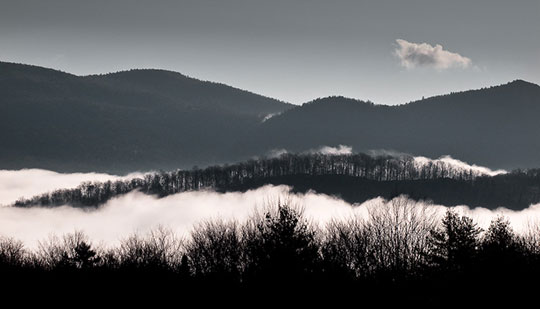
Chittenden Fog. Chittenden, Vermont October 2008
Canon G10 @ ISO 80
25mm (120 mm equiv) – 1/2000sec @ f/5
An example of this can be seen in the image above, of which a 100% detail of a smooth mid-tone area is seen below. While the resolution is extraordinary there is visible luminance noise at ISO 80. This is invisible in light toned areas, and in areas with lots of detail, but becomes visible in smooth mid and dark toned areas.
Fortunately, in the case of both the G10 and the P6000 this is luminance noise and thus looks very much like film grain. In this instance I’d judge it equivalent to ISO 100 film. Beyond ISO 400 though these cameras start to show chroma noise, which is much more objectionable.

Noise / High ISO / Dynamic Range
Judging noise and high ISO as well as dynamic range is never easy because where signal stops and noise begins is visually subjective. Unless one has a properly set up lab, measuring these isn’t terribly effective or reliable. Instead, here are a few real-world tests.
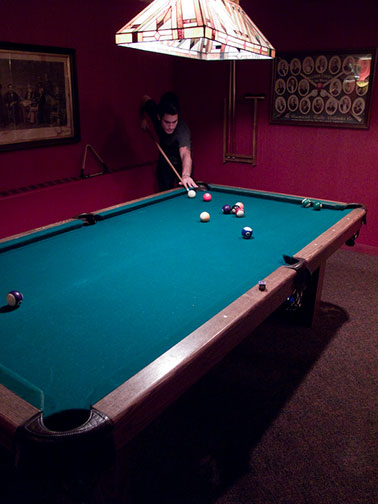
Billiards – ISO 400. 28mm equivalent
The above was shot at ISO 400 with one of the cameras. It isn’t necessary to say which, since I found both cameras quite similar in their noise levels at all settings. The differences in this regard are a quibble. ISO 400 is quite usable, and only requires some luminance smoothing and a small bit of chroma noise reduction to produce quite a clean image.
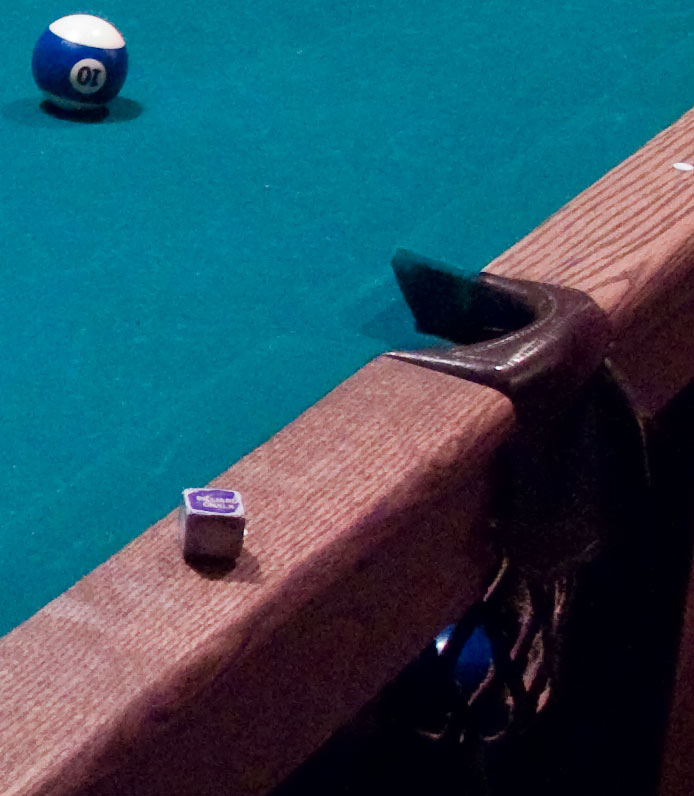
ISO 400 detail
Let’s now go to the extreme – ISO 1600. How bad is it?
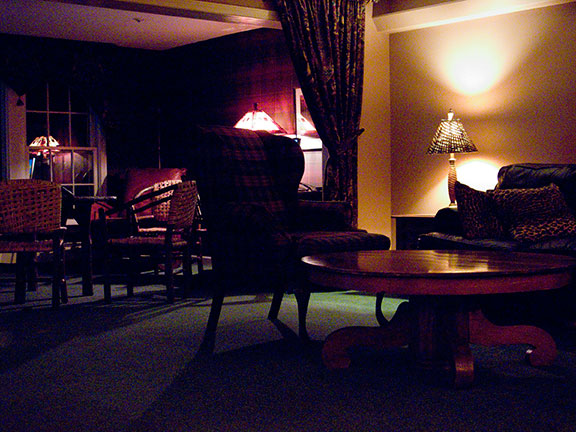
Canon G10 @ ISO 1600
At small screen and print sizes, not as bad as one might fear, though considerably nosier than just about any DSLR at this speed. Indeed the Nikon D3 and D700 are essentially noise free at this speed. But when viewed on a largish print, or at 100% on screen, the noise from these two cameras really becomes visible.
Below is such a detail from the frame above. This lighting situation is typical of the conditions where one would likely shoot at such high speed – in a low but harshly lit room.
The frame immediately below is a 100% detail from the above and has had no noise reduction applied. Nasty – with both luminance as well as lots of chroma noise.

Canon G10 @ ISO 1600 – Detail – no noise reduction
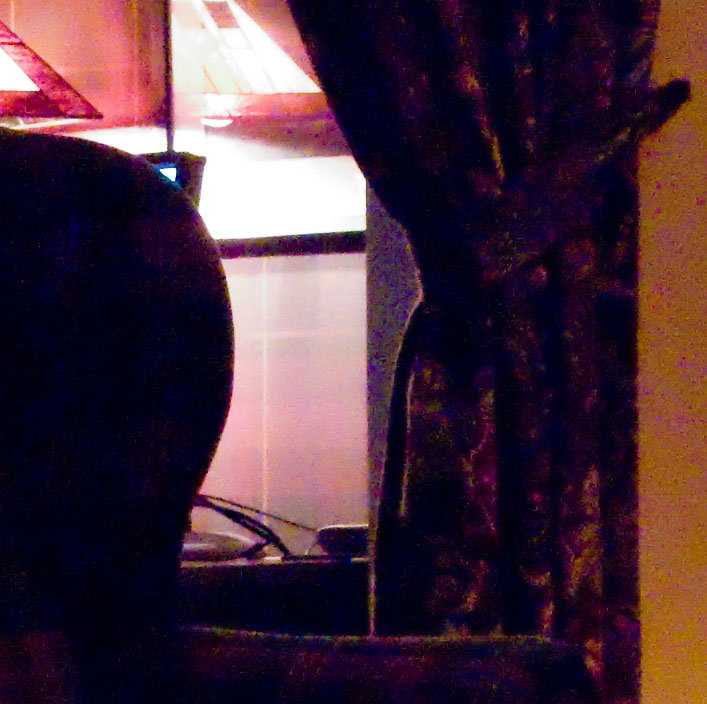
Canon G10 @ ISO 1600 – Detail – maximum Lightroom 2.1 noise reduction
This version has had maximum noise reduction applied in Lightroom 2.1 Neither frame has had any sharpening applied. If necessary this file could be processed with Noise Ninja or Noiseware Pro, both of which would have cleaned up the image to a further degree, but of course at the expense of detail.
____________________________________________________________________________________
Fringing
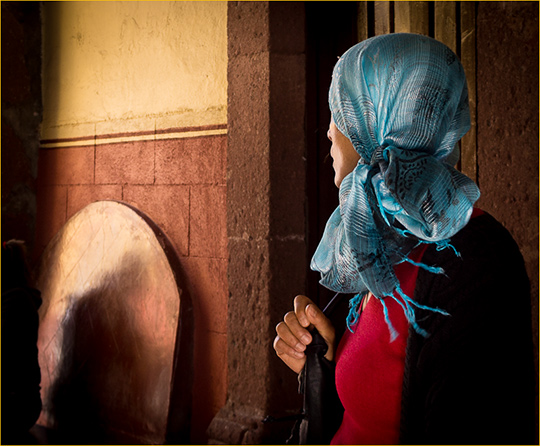
On Reflection. Muskoka, Ontario. October, 2008
Nikon P6000 @ ISO 155
All digital cameras suffer to some extent from fringing on bright highlights. Pocket cameras with tiny photo sites are particularly prone to this.
The frames below were taken at the same time from the same spot. The Canon file is slightly larger because of its somewhat higher resolution sensor, and the focal lengths aren’t exactly the same, as this is almost impossible to set accurately on either camera due to the stepped zooming controls.
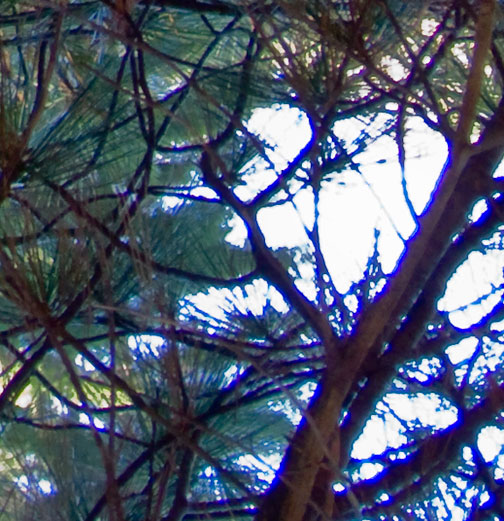

1/60 sec f/3.1 ISO 155
8.1mm focal length
1/150 sec f/3.2 ISO 200
9.78mm focal length
The Nikon has significantly more fringing on extreme blown contrasty highlight edges than does the Canon, as seen above on a 100% crop. The G10 appears to be as well controlled in this area as any digicam I’ve yet tested.
____________________________________________________________________________________
Resolution
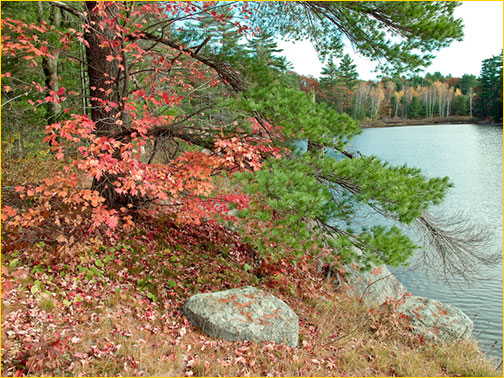
After an extensive series of real-world tests at several different apertures and focal lengths, I am comfortable in writing that the Canon G10 is noticeably sharper than the Nikon P6000. The 100% crop below shows this in shots taken at about 6mm, and at each camera’s lowest ISO. The Nikon file is on the left and the Canon file is on the right.
I do not know if this is attributable to the sensor or the lens, or a combination of the two, but the differences are clearly visible on-screen and in prints. Not that the P6000 is poor. Indeed it is typical of cameras of this type, and not much different than the Panasonic LX3. It’s just that the G10 appears to offer appreciably higher resolution images in every case that I have looked at.

Please note that in many of these comparisons you will see the file from the Canon G10 indicated as a .TIF.
The reason for this is that these comparison views, done at 100% in Lightroom, are directly from the raw file
in the case of the Nikon .NRF, but from a TIFF file generated by another raw processing program
in the case of the Canon. This does not materially affect the comparisons since similar raw processing
and sharpening have been performed on each file.
____________________________________________________________________________________
Automated Decisions

Birch and Leaves. Algonquin Park. Ontario. October, 2008
Canon G10 @ ISO 200
This example shows similar shots taken with both cameras. Both cameras were in Program mode with Auto-ISO set. What you’ll notice at first is that the Canon is at ISO 200, while the Nikon is at ISO 400.Not fair, you say. We’ll maybe. But here’s what this is about.
What I have observed about the way that the G10 works is that it tries to keep the aperture fairly wide – usually at about f/4. The Nikon doesn’t appear to do this. That’s why in this example the Nikon chose ISO 400 while the Canon chose ISO 200. The Nikon therefore chose a small aperture (f/5.9) while the Canon chose f/4. Why the Nikon chose to use a higher ISO and therefore a smaller aperture isn’t known, but the reason why the Canon did the inverse makes sense. Small sensor cameras like this suffer from diffraction once they are stopped down more than a stop or at most two from wide open. This goes a long way to explaining why the Canon file on the right (below) looks a lot sharper than that from the Nikon, notwithstanding the ISO difference.
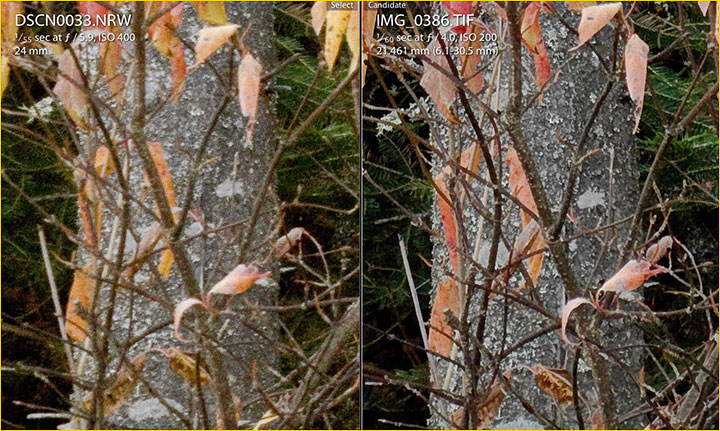
Further testing of this showed me that more often than not, when used in Auto ISO mode (low) the G10 prefers to keep the aperture as wide as possible and utilize a low ISO, while the Nikon acts more like a DSLR, using a smaller aperture and increasing ISO.
Of course in none-Auto-ISO mode this is all left in the hands of the photographer and therefore can easily be overcome, but it’s interesting to note the different approaches taken by the two companies.
It is worth noting as well in the feature department that Canon provides a built-in neutral density filter that allows one to keep the aperture wide and the shutter speed down when shooting in very bright conditions, something that the P6000 does not offer.
____________________________________________________________________________________
Video
Both the G10 and P6000 have 640 X 480 30FPS video capability. Neither is sterling, nor terrible. The Panasonic LX3 on the other hand follows the latest trend offering HD video quality at 1280 X 720 at 24FPS, and the video quality is quite good for such a small camera – certainly superior to either the Nikon or Canon.
Note that the Canon G10 has switched to H264, a much better codec in terms of efficiency than Motion JPG, previously used in the G series.
____________________________________________________________________________________
The G10 Compared to the G9
Though superficially similar, the G9 and G10 are quite different cameras. The sensor is different, the lens is different, and the build and user interface / controls are new as well.
I would appear that with the G9 Canon was testing the waters in an almost half-hearted way. They didn’t even update their raw software to support it properly. But with the G10 Canon appears to have taken a fresh look at this format. Without going into unnecessary detail, compared to the G9 the G10 is a much more responsive camera – indeed virtually a different camera.
Nikon’s P6000, on the other hand, seems to be a first generation product rather than a follow-on, so it remains to be seen what direction that company takes with its evolution.

Sunset Lake – Green Mountain National Forest. Vermont. October, 2008
Canon G10 @ ISO 200
____________________________________________________________________________________
The Wrap Up
When I published myG10 / medium format piecethe week before this first appeared I expected an onslaught of critical commentary. Instead what I saw was mostly positive, with some folks who had already had a chance to shoot with the G10 affirming what I am seeing with their own experiences. There were a few naysayers, including one that claimed thatamateurslike me who have no idea of what a decent image looked like shouldn’t do such comparisons. Or, the one that wrote that since I was such abad photographerhow could anyone trust my opinion. OK – if that’s the way you see it. Welcome to the wacky Internet.
But what I think happened was that thoughtful folks, those interested in understanding what’s going on rather than in scoring puerile digs, actually downloaded the G10’s sample files that I provided and made their own prints. That’s all it took.
As for this comparison with the Nikon P6000, it was planned long before I discovered how good the G10 actually is. In fact I purchased both cameras at retail for this test because Nikon couldn’t (?) provide me with a sample in a timely manner, and Canon is shipping the G10 a month later in Canada than in the US and so a test sample wasn’t readily available when I needed it.
The net of this comparison is that while the Nikon P6000 is a fine little camera, it finds itself in the unfortunate position of being released at the same time as the Canon G10, which it would appear is an attempt by Canon to produce a full-featured pocket camera with the highest quality that they are capable of. In this they appear to have succeeded, unlike with last year’s G9, which was a decent camera, but which didn’t seem to be a whole-hearted effort on Canon’s part.
The P6000 holds up well against the Panasonic LX-3, with both of them being similarly sized. The G10 is quite a bit heavier and bulkier, with the trade-off being its higher image quality, better build, and superior features over the P6000, such as a multi-frame raw buffer and live histogram.
What unbalances the equation is that at this time these two cameras are priced the same. If the Nikon were lower priced I could see an argument for it, but not at $500. The LX3 offers an even smaller size, variable aspect ratios, and a usable raw buffer, along with a lower price. Add to this a wider and faster lens, if that’s what your style of shooting needs, and regrettably the Nikon P6000 then finds itself uncompetitive with either of the other two.
Nikon is not to be counted out though. I’ve been blown away by the Nikon D3. Its image quality is thusfar unsurpassed in a DSLR, and now with the D700 Nikon is pushing the envelope on price as well. I prefer Nikon’s DSLR handling and user interface to Canon’s, and I also feel that Nikon is on a roll with some of its new lenses, surpassing Canon in several focal lengths, especially at the wide end.
With the P6000 Nikon has joined the raw / optical viewfinder / pocket digicam sweepstakes, but doesn’t seem to have delivered the goods they way it has of late in the DSLR arena. I look forward to their next attempt in this category. In the meantime I can wholeheartedly recommend the Canon Powershot G10 to anyone looking for a high quality coat pocket-sized digital camera with raw capability.
October, 2008
You May Also Enjoy...
The Leica M8 in Antarctica
All of man’s forays into Antarctica have an element of romantic folly. My own folly as a traveller on Michael’s recentAntarctic Questwas bringing my Leica


